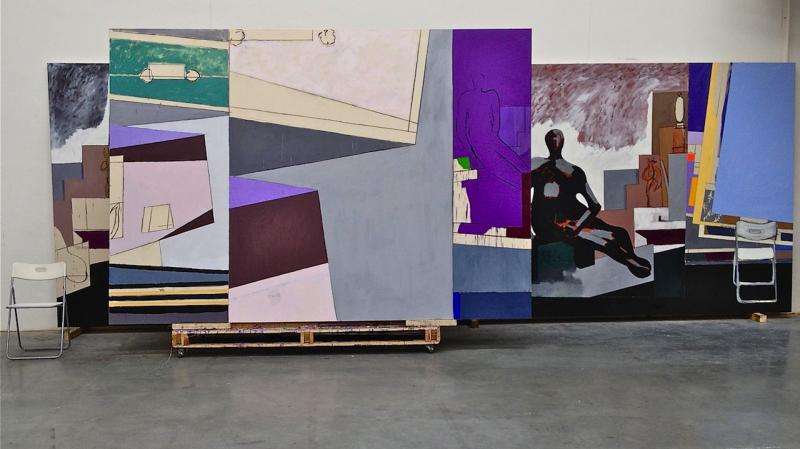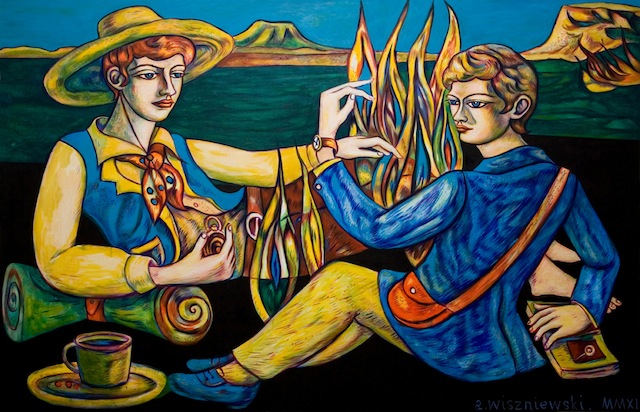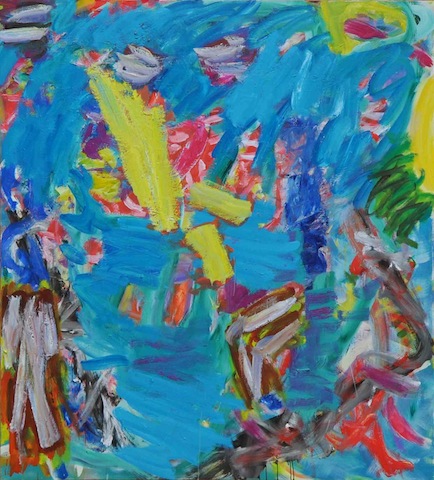I Cheer a Dead Man's Sweetheart, De La Warr Pavilion | reviews, news & interviews
I Cheer a Dead Man's Sweetheart, De La Warr Pavilion
I Cheer a Dead Man's Sweetheart, De La Warr Pavilion
An exhibition of painting that has no set agenda, no dogma, and is full of bold gestures

Given the kooky title of a new painting show at De La Warr Pavilion, it seems necessary to point out, yet again, that painting isn’t dead. The line is from poet A.E Housman, who wrote a versified dialogue between a dead man and his living friend. So while certain painters may be dead, contemporaries can talk to them. And that’s what 21 painters line up to do in this new, undogmatic survey on the South Coast. Rest assured, the conversation is breezy.
Co-curators David Rhodes and Dan Howard-Birt have taken the bright decision to show artists who are “emerging”, mid-career and senior. Where else might Frank Auerbach rub shoulders with a recent graduate like Joella Wheatley? Another driver behind the appeal of this show is the legwork put in by the curators. In almost every case, they have visited painters in their studio and asked for their most recent wares. As a result the work feels immediate, cherished, and very much concerned with the present.
But an exhibition in a gallery, no matter how much of a reward, is an interruption to studio time. If painters move on, their work is always already an anachronism. Such is the suggestion of a work here, by Adrian Wiszniewski (pictured below), that tees up the rest of the show. It is a well-drafted folky scene with two backwoodsmen sat by an unruly fire. One holds up his wrist watch, the other retrieves a fob from his pocket. The visitor is left to wonder what, according to the title, is The First Anachronism of the Day. Is could be painting; it could be figuration. Or given the blue sky, most likely it is the flames, decorative here, and picked out in solid black lines and non-naturalistic colours.
 Step back (or forward) in time and you find yourself in the main body of a show which gives its artists plenty of space and, in most cases, two or three places on the wall. Here you find another anachronism, a nondescript stick painted turf green. Hayley Tompkins could be offering a painterly riposte to Duchamp or a feminine take on the macho tendency for Abstract Expressionist painters to trade brushes for sticks. And so a poor material is elevated by a degree of wit and engagement.
Step back (or forward) in time and you find yourself in the main body of a show which gives its artists plenty of space and, in most cases, two or three places on the wall. Here you find another anachronism, a nondescript stick painted turf green. Hayley Tompkins could be offering a painterly riposte to Duchamp or a feminine take on the macho tendency for Abstract Expressionist painters to trade brushes for sticks. And so a poor material is elevated by a degree of wit and engagement.
Humour runs through this show. John Wonnacott paints an interior with a couple of well-to-do residents, their pedigree dogs, their piano and their sweeping staircase. The couple appear to be the patrons of this vivid, silvery work of art. But when noticing a liveried forearm breaking the right side of the picture plane, they may have balked. This, we assume, belongs to their butler. He carries a tray with two glasses of champagne. Or perhaps the butler is also the artist. If so it is a brilliant way to puncture the abundant display of their worldly success.
 Some abstract work is almost as comic, and certainly as cheerful. Gary Wragg could stop you in your tracks with one of his large-scale canvases in which no colour or mix of colours is considered excessive. In Blue/Yellow Streak (pictured right) he substitutes the lapis lazuli and the gold leaf of early Renaissance painting with a searing lemon yellow and an overwhelming field of pure blue. Thick paint offers sensual pleasures, while square brush strokes make the whole solid and satisfying. It is as balanced as the modernist building which houses this show.
Some abstract work is almost as comic, and certainly as cheerful. Gary Wragg could stop you in your tracks with one of his large-scale canvases in which no colour or mix of colours is considered excessive. In Blue/Yellow Streak (pictured right) he substitutes the lapis lazuli and the gold leaf of early Renaissance painting with a searing lemon yellow and an overwhelming field of pure blue. Thick paint offers sensual pleasures, while square brush strokes make the whole solid and satisfying. It is as balanced as the modernist building which houses this show.
The whole exhibition is full of bold gestures. Sophie von Hellermann has painted a mural in situ, a light pastoral scene which seems to be in dialogue with the sunlight that bathes this stretch of the gallery on the day of my visit. It is also in dialogue with a painting by Alessandro Raho, around which it playfully gambols and frolics. Raho’s painting takes a male model as the subject. He looks more fashion than art. And with a giant Moschino branded heart on his T-shirt he is a candidate to become the sweetheart of the show’s title. This is painting as pin-up.
Another brush with fashion can be found in a piece by Lisa Milroy, who has painted fabric and then sewn the results together to present shapeless, functional dresses. There are seven on display here, perhaps eight if you count the loose garment which gets modelled now and again by gallery staff. Staging a catwalk in a gallery is another light touch of self parody.
But not so far away it's also theatre. Three monumental works by Bruce McLean are up on blocks as if ready to be towed out of the wings and onto the stage (main picture). Angular planes in cool colours may not hint at a riot of entertainment. But they draw you in with references to sculptors Moore, Brancusi and Caro. To one side the artist has placed a folding chair. The chair also appears painted and facing the other way. And this doubled chair also calls to mind the three conceptual chairs of Joseph Kosuth. Indeed, there’s enough material in this one installation to sustain a show by itself. Here it’s simply a fine example of the curators’ pushing against the limits of their chosen medium.
Both Milroy and McLean can be found on the first floor, where organisers plan to further engage the public with a working studio during Easter. To bring the production zone into the gallery makes for a heady lifting of the veil. But it means that the scope of this show, while limited to two score painters and some 50 works, is much wider than the gallery dimensions at DLWP should shallow. A working studio at an art venue is as out of place as that campfire in the middle of the day. So live painting may be an anachronism, but in these conditions, with these results, at the present moment, paint is hard to contain, and hot.
Explore topics
Share this article
The future of Arts Journalism
You can stop theartsdesk.com closing!
We urgently need financing to survive. Our fundraising drive has thus far raised £49,000 but we need to reach £100,000 or we will be forced to close. Please contribute here: https://gofund.me/c3f6033d
And if you can forward this information to anyone who might assist, we’d be grateful.

Subscribe to theartsdesk.com
Thank you for continuing to read our work on theartsdesk.com. For unlimited access to every article in its entirety, including our archive of more than 15,000 pieces, we're asking for £5 per month or £40 per year. We feel it's a very good deal, and hope you do too.
To take a subscription now simply click here.
And if you're looking for that extra gift for a friend or family member, why not treat them to a theartsdesk.com gift subscription?
more Visual arts
 'We are bowled over!' Thank you for your messages of love and support
Much-appreciated words of commendation from readers and the cultural community
'We are bowled over!' Thank you for your messages of love and support
Much-appreciated words of commendation from readers and the cultural community
 Photo Oxford 2025 review - photography all over the town
At last, a UK festival that takes photography seriously
Photo Oxford 2025 review - photography all over the town
At last, a UK festival that takes photography seriously
![SEX MONEY RACE RELIGION [2016] by Gilbert and George. Installation shot of Gilbert & George 21ST CENTURY PICTURES Hayward Gallery](https://theartsdesk.com/sites/default/files/styles/thumbnail/public/mastimages/Gilbert%20%26%20George_%2021ST%20CENTURY%20PICTURES.%20SEX%20MONEY%20RACE%20RELIGION%20%5B2016%5D.%20Photo_%20Mark%20Blower.%20Courtesy%20of%20the%20Gilbert%20%26%20George%20and%20the%20Hayward%20Gallery._0.jpg?itok=7tVsLyR-) Gilbert & George, 21st Century Pictures, Hayward Gallery review - brash, bright and not so beautiful
The couple's coloured photomontages shout louder than ever, causing sensory overload
Gilbert & George, 21st Century Pictures, Hayward Gallery review - brash, bright and not so beautiful
The couple's coloured photomontages shout louder than ever, causing sensory overload
 Lee Miller, Tate Britain review - an extraordinary career that remains an enigma
Fashion photographer, artist or war reporter; will the real Lee Miller please step forward?
Lee Miller, Tate Britain review - an extraordinary career that remains an enigma
Fashion photographer, artist or war reporter; will the real Lee Miller please step forward?
 Kerry James Marshall: The Histories, Royal Academy review - a triumphant celebration of blackness
Room after room of glorious paintings
Kerry James Marshall: The Histories, Royal Academy review - a triumphant celebration of blackness
Room after room of glorious paintings
 Folkestone Triennial 2025 - landscape, seascape, art lovers' escape
Locally rooted festival brings home many but not all global concerns
Folkestone Triennial 2025 - landscape, seascape, art lovers' escape
Locally rooted festival brings home many but not all global concerns
 Sir Brian Clarke (1953-2025) - a personal tribute
Remembering an artist with a gift for the transcendent
Sir Brian Clarke (1953-2025) - a personal tribute
Remembering an artist with a gift for the transcendent
 Emily Kam Kngwarray, Tate Modern review - glimpses of another world
Pictures that are an affirmation of belonging
Emily Kam Kngwarray, Tate Modern review - glimpses of another world
Pictures that are an affirmation of belonging
 Kiefer / Van Gogh, Royal Academy review - a pairing of opposites
Small scale intensity meets large scale melodrama
Kiefer / Van Gogh, Royal Academy review - a pairing of opposites
Small scale intensity meets large scale melodrama
 Jenny Saville: The Anatomy of Painting, National Portrait Gallery review - a protégé losing her way
A brilliant painter in search of a worthwhile subject
Jenny Saville: The Anatomy of Painting, National Portrait Gallery review - a protégé losing her way
A brilliant painter in search of a worthwhile subject
 Abstract Erotic, Courtauld Gallery review - sculpture that is sensuous, funny and subversive
Testing the boundaries of good taste, and winning
Abstract Erotic, Courtauld Gallery review - sculpture that is sensuous, funny and subversive
Testing the boundaries of good taste, and winning
 Edward Burra, Tate Britain review - watercolour made mainstream
Social satire with a nasty bite
Edward Burra, Tate Britain review - watercolour made mainstream
Social satire with a nasty bite

Add comment